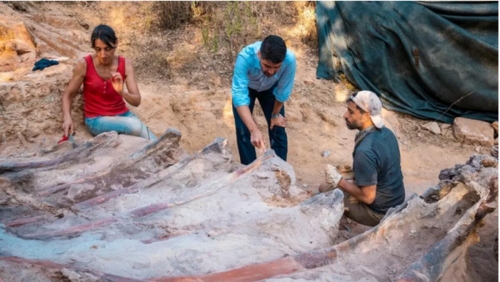Europe's largest dinosaur skeleton found in man's backyard
Agencies | Brussels
The Daily Tribune – www.newsofbahrain.com
The remains of what can be the largest dinosaur to be found in Europe are being uncovered in a backyard in Pombal, city in the central region of Portugal.
The remains, which could correspond to a sauropod dinosaur with approximately 12 meters high and 25 meters long, are now being studied by an international research team.
It all started in 2017. The owner of a property in Pombal, Portugal, noticed the presence of several fragments of fossilized bones in his yard, when carrying out construction works, and contacted the research team, which carried the first excavation campaign in that same year.
More recently, between August 1 and 10, 2022, Portuguese and Spanish palaeontologists working on the site have been unearthing what can be the remains of the largest sauropod dinosaur to be found in Europe. Sauropods are herbivorous, quadrupedal dinosaurs, with long neck and tails.
“It is not usual to find all the ribs of an animal like this, let alone in this position, maintaining their original anatomical position. This mode of preservation is relatively uncommon in the fossil record of dinosaurs, in particular sauropods, from the Portuguese Upper Jurassic”, says Elisabete Malafaia, Postdoctoral researcher at the Faculty of Sciences of the University of Lisbon (Ciências ULisboa), Portugal.
So far, an important set of elements of the axial skeleton has been collected from the site, which includes vertebrae and ribs of a possible brachiosaurid sauropod dinosaur. The Brachiosauridae group is composed of large species that lived from the Upper Jurassic to the Lower Cretaceous, approximately 160 to 100 million years ago, and are characterized by the presence of markedly developed forelimbs. Some of the most emblematic dinosaur species belong to this group of sauropods, such as Brachiosaurus altithorax and Giraffatitan brancai, as well as the Portuguese Late Jurassic species found in Portugal’s West region, Lusotitan atalaiensis.
The preservation characteristics of the fossils and their disposition indicate the possible presence of other parts of the skeleton of this individual, a hypothesis that will be tested in future excavation campaigns in the deposit.
“The research in the Monte Agudo paleontological locality confirms that the region of Pombal has an important fossil record of Late Jurassic vertebrates, which in the last decades has provided the discovery of abundant materials very significant for the knowledge of the continental faunas that inhabited the Iberian Peninsula at about 145 million years ago”, adds Elisabete Malafaia.
The work is being carried out by researchers from Instituto Dom Luiz at Ciências ULisboa (Portugal), the Evolutionary Biology Group at UNED-Madrid (Spain) and the Faculty of Fine Arts at Complutense University of Madrid (Spain), and had the support of the Pombal City Council.
Related Posts

